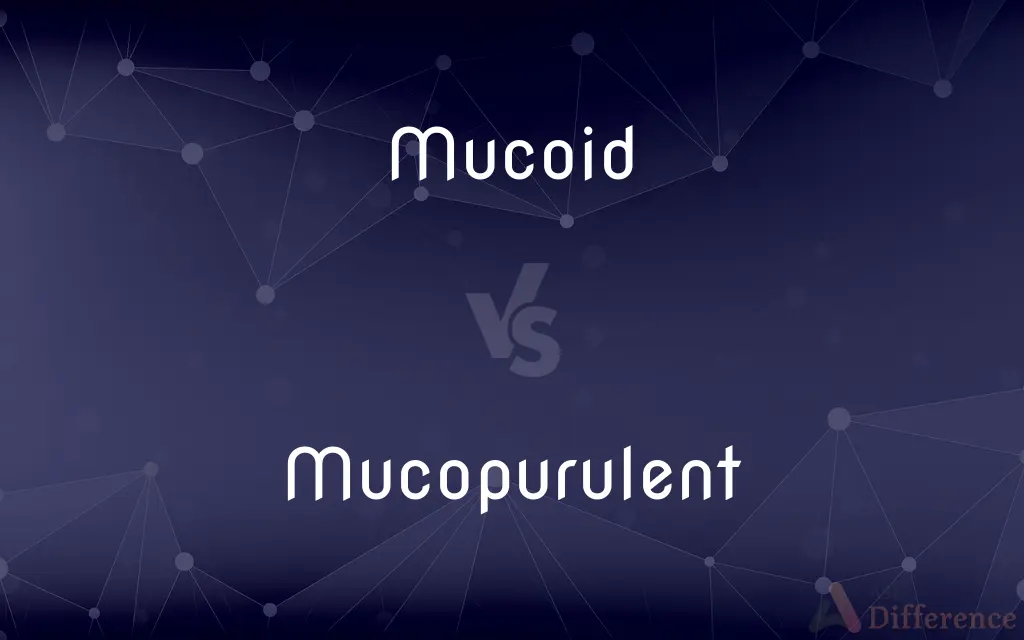Mucoid vs. Mucopurulent — What's the Difference?
Edited by Tayyaba Rehman — By Urooj Arif — Updated on April 27, 2024
Mucoid refers to a clear, slimy substance typical of mucus, while mucopurulent denotes a mixture of mucus and pus, indicating infection.

Difference Between Mucoid and Mucopurulent
Table of Contents
ADVERTISEMENT
Key Differences
Mucoid discharge is generally clear and slippery, associated with normal secretions or mild irritations. Whereas, mucopurulent discharge is cloudy and thicker due to the presence of pus, often signaling bacterial infection.
Mucoid substances are typically found in conditions like colds or allergic reactions, serving to protect and moisturize tissues. On the other hand, mucopurulent discharges are common in more severe infections such as bronchitis or sinusitis, where pus formation occurs due to the immune response.
The appearance of mucoid secretions can be translucent to slightly opaque. Conversely, mucopurulent secretions are usually yellowish or greenish, indicating the presence of white blood cells.
In medical diagnosis, observing mucoid characteristics can suggest non-infectious causes. However, the detection of mucopurulent qualities often leads to further testing for bacterial infections, guiding appropriate antibiotic treatment.
The treatment for conditions presenting mucoid symptoms often involves managing discomfort and addressing the underlying cause, such as allergies. In contrast, mucopurulent conditions may require more aggressive treatment such as antibiotics to clear the infection.
ADVERTISEMENT
Comparison Chart
Definition
Clear, slimy secretion
Cloudy secretion containing pus
Typical Causes
Allergies, colds
Bacterial infections
Appearance
Translucent, non-cloudy
Yellowish, greenish, cloudy
Indication
Often non-infectious
Suggests infection
Common Treatments
Symptom management, hydration
Antibiotics, medical intervention
Compare with Definitions
Mucoid
A type of secretion resembling mucus.
The mucoid discharge from his nose was due to seasonal allergies.
Mucopurulent
A discharge consisting of both mucus and pus.
The mucopurulent sputum suggested a bacterial lung infection.
Mucoid
Common in respiratory and gastrointestinal tracts.
Mucoid stools can indicate an irritation in the intestines.
Mucopurulent
Indicates infection or disease.
Mucopurulent discharge from the eye warrants immediate medical attention.
Mucoid
Slimy and clear in nature.
She noticed a mucoid texture in the plant extract.
Mucopurulent
Usually associated with inflammation.
Mucopurulent symptoms in chronic bronchitis are common.
Mucoid
Often increased by irritants.
Exposure to dust led to increased mucoid secretion.
Mucopurulent
Requires medical intervention.
His mucopurulent condition improved after starting antibiotics.
Mucoid
Non-infectious in most scenarios.
The mucoid buildup in his eyes was more annoying than harmful.
Mucopurulent
Can be seen in various body sites.
Mucopurulent nasal discharge is a sign of sinus infection.
Mucoid
Any of various glycoproteins, especially a mucoprotein, similar to the mucins.
Mucopurulent
Consisting of mucus and pus.
Mucoid
Of, relating to, or resembling mucus.
Mucopurulent
Containing mucus and pus.
Mucoid
Pertaining to or resembling mucus; mucous.
Mucopurulent
(medicine) Characterized by mucus and pus.
A mucopurulent discharge
Mucoid
Any of a class of mucin-like substances yielding on decomposition a reducing carbohydrate together with some form of proteinaceous matter.
Mucopurulent
Having the character or appearance of both mucus and pus.
Mucoid
Resembling mucus.
Mucopurulent
Containing or composed of mucus and pus
Mucoid
One of a class of mucinlike substances yielding on decomposition a reducing carbohydrate together with some form of proteinaceous matter.
Mucoid
Any of several glycoproteins similar to mucin
Mucoid
Relating to or resembling mucus;
A mucoid substance
Common Curiosities
What are common treatments for mucopurulent conditions?
Mucopurulent conditions often require antibiotics or other medical treatments to address underlying infections.
How can you tell mucoid from mucopurulent?
Mucoid is clear and slimy, while mucopurulent is typically cloudy and colored due to pus.
What does mucopurulent mean?
Mucopurulent refers to a discharge that contains both mucus and pus, often due to infection.
What causes mucoid discharge to appear in the respiratory system?
Mucoid discharge in the respiratory system is often caused by viral infections, allergies, or irritants like smoke and pollution.
Can children and adults have different responses to mucoid and mucopurulent discharges?
Yes, children might respond differently to mucoid and mucopurulent discharges due to their developing immune systems, often requiring closer monitoring and different treatment approaches.
Can mucoid secretions turn into mucopurulent?
Yes, mucoid secretions can become mucopurulent if an infection develops.
What should you do if you have mucopurulent discharge?
If you have mucopurulent discharge, it is advisable to seek medical evaluation as it may indicate an infection that requires treatment such as antibiotics.
Are there specific tests to differentiate mucoid from mucopurulent discharges?
Yes, medical professionals can use lab tests, such as microscopy and culture, to analyze the discharge and identify whether it is mucoid or mucopurulent.
Can both mucoid and mucopurulent discharges occur at the same time?
Yes, it is possible for an individual to exhibit both mucoid and mucopurulent discharges, especially in cases of evolving or complicated infections.
What is mucoid discharge?
Mucoid discharge is a clear, slimy secretion typical of normal mucus production.
How do the treatments for mucoid and mucopurulent discharges differ?
Treatments for mucoid discharges focus on relieving symptoms and removing irritants, whereas mucopurulent discharges often require targeted antibiotic therapy to treat the underlying infection.
Is mucopurulent discharge contagious?
Mucopurulent discharge can be contagious, depending on the underlying cause, particularly if it is caused by bacterial or viral infections.
How long does it typically take for mucopurulent discharge to resolve with treatment?
The duration for mucopurulent discharge to resolve can vary widely, but with appropriate antibiotic treatment, symptoms often improve within a few days to a week.
What preventive measures can be taken to avoid developing mucopurulent discharge?
Preventive measures include maintaining good hygiene, avoiding known irritants and allergens, and staying up to date with vaccinations.
What are the long-term effects of recurrent mucopurulent discharges?
Recurrent mucopurulent discharges can lead to chronic infections, increased susceptibility to further infections, and in some cases, damage to the mucosal linings of the affected areas.
Share Your Discovery

Previous Comparison
Asymmetric vs. Unsymmetrical
Next Comparison
Pillage vs. RaidAuthor Spotlight
Written by
Urooj ArifUrooj is a skilled content writer at Ask Difference, known for her exceptional ability to simplify complex topics into engaging and informative content. With a passion for research and a flair for clear, concise writing, she consistently delivers articles that resonate with our diverse audience.
Edited by
Tayyaba RehmanTayyaba Rehman is a distinguished writer, currently serving as a primary contributor to askdifference.com. As a researcher in semantics and etymology, Tayyaba's passion for the complexity of languages and their distinctions has found a perfect home on the platform. Tayyaba delves into the intricacies of language, distinguishing between commonly confused words and phrases, thereby providing clarity for readers worldwide.














































